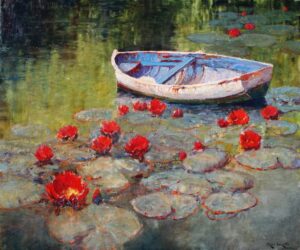
I always use a very high quality, pre-primed, heavy-duty linen canvas by a leading manufacturer. I also choose a very coarse linen. Why? When observed very closely, the surface of such canvas is a series of round bumps linear in both directions.
Once I have suggested the drawing, or perhaps more correctly the positioning of my masses, I like to color the canvas with a wash of chosen color. I never use pure turpentine, only because it denies any body in the pigment in places on the canvas where no other paint will cover this wash which, without the addition of oil, will not survive time.
At this point in the procedure, I have no white or opaque colors on my palette. The result is an effect as pure in color as a watercolor on white paper. Often the most gorgeous colors are dark and intense. Here I might bypass the wash and apply the pigment without medium. Then because I require a lift in the tone or lightness of an area, I use a knife to scrape off most of the paint. Now because the canvas has all its multiple mini-projectories, the paint will be left only in the recesses of the canvas. So, actually what happens is that the white of the canvas bumps is seen through the applied pigment. From very close, it appears spotty, but from afar, the eye reads a lighter value of a delightful dark pigment which has in no way lost its transparency or luminosity. Also because the paint is so recessed in the canvas texture, one can apply either a scumble or impasto without drying time.
At this point, I normally choose to scumble, also because being so thin and adhering to the canvas projectories only it will harden quickly. Until I really have my picture talking to me, I don’t choose to paint wet in wet.
What I’m describing is more for large canvasses in one’s studio. Plein air small works don’t belong to this category. Small plein air, one tends to go in fully loaded. There is too much wind and way too many bugs to do anything else.
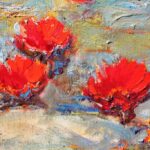
Scumbling, a very light touch to the canvas with a large flat brush using undiluted paint, will offer numerous effects but never totally cover the wash or the scratched areas. Otherwise, why bother to put them in, in the first place. Every stage is part of the finished painting.
Now comes the impasto. For some reason or another, lumpy paintings have become the vogue. The idea of a lump on a canvas is that under angular lighting, a lump will catch the beam of light and visually leap off the canvas. Now this is great for highlights in high-toned colors. If the painting is ultimately varnished, your lumps will “shine” as well under spotlights. If you don’t want shine or glitter, don’t lump. Lumps in a dark area glisten and totally destroy the intensity of the dark. Recently, I saw a show where the whole painting was lumps. Wonderful for the manufacturer but a disaster to the painting – and the viewer!
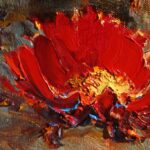
Painting florals is interesting. A knife is good, but it tends to lose the delicacy and femininity of a petal. As petals of a rose, for example, are so perfect a non-textural finish is needed. No shadows are required in a petal under the sun. A brush stroke will leave fiber striations, which cast minute shadows. A latex gloved finger will give you a petal beyond your expectations. But use a new finger for every application. Otherwise, you will have the most devastating mud pie!
There is no need at any stage of a painting to apply any pigment which will not be seen in the finished work. One can, of course, rub color over another color to create a secondary value – but let’s not get too complicated!
Oil Painting
It’s Just Paint and Canvas

Lines, colors, shapes, usually on a flat rectangular surface: that’s how we most often define “a painting.” As an objet d’art it has perceived value, both inside and out of the marketplace. Often paintings contain little or no moving parts. Precious metals may be employed, but not usually — it’s simply canvas by-the-yard and pigment. The materials of which a painting is made today are not much different than they were thousands of years ago, when early man painted and engraved shapes of animals on cave walls, with crushed plants and vegetable matter for paint, and animal-fat crayons and fingertips for brushes. The technology of paint-making and the variety of painting surfaces have significantly improved since then, but paint is still made of pigments and the surface of a painting is still usually flat. Doesn’t sound that impressive, does it?
“The synthesis of truth and beauty…is the highest and deepest reality.”Ovid

“ We keep our eyes on the things we cannot see: for the things which we can see are temporal; the things that are unseen are eternal.”2 Corinthians 4:18

The artist is the catalyst in this process of Imagineering and revelation. It is through the artist’s eye that new possibilities can be discovered, and comprehended. In fact, former President John F. Kennedy underlined that creative significance: “I see little of more importance to the future of our country and of civilization than full recognition of the place of the artist. If art is to nourish the roots of our culture, society must set the artist free to follow his vision wherever it takes him.” The painter does what the director does for a film, or the composer for a symphony. He or she draws unrelated concepts together, instills pattern, variety and unity, and discloses the essence of an idea. If we look through the painter’s lens, we are treated to a new perspective on reality. The visionary artist is a conductor on the journey to an exotic destination. We begin to understand that here is something higher in that artwork, than just paint and canvas.
“An artist is not paid for his labor, but for his vision.”James Abbot McNeill Whistler
For a painting, it is the experience of the artist expressed therein that is of utmost value. The material nature of the work is quite secondary. A painting that conveys the power of emotion to the viewer is more than “just paint and canvas.” It is the description of a heartfelt concept that has been forged into tangible excellence through a creative process of envisioning and technical facility. It even has the power to change lives. “(Art) has the capacity to penetrate even the most callous skin and to ignite a revolution from within,” as musician Benjamin Moore so eloquently reminds us. Pursuing art with our whole hearts and minds is probably the most civilizing undertaking we can do as artists. “What a privilege it is to be able to take brush in hand and put paint on paper in this troubled world,” is our encouragement from artist Veronica Stensby.
A painting’s value is not in its material nature, as “just paint and canvas.” Rather, it is the vision an artist expresses with those materials that is of value: that slice of heaven, the best of the Best, that idea of the Ideal, that is the central core of both the material and spiritual worth of an artwork.
Stylistic Unity
Two years ago I had my work critiqued through Oil Painters of America. Todd Williams was the Signature Member who looked at images of ten of my current paintings. He gave me some very helpful insight into my work and useful suggestions. One particular idea he proposed to me was very surprising and has resulted in unexpected changes in the direction of my work.
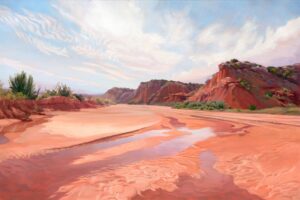
This is the painting he was discussing. He said something like this: “I notice that you have stylized the clay in the riverbed at the foreground, but you have not stylized the bluffs or sky in the same way. So I am suggesting that you consider the idea of whether you would wish to have stylistic unity in your painting.”
I had never heard anyone talk about stylistic unity, nor had I considered such an idea when making this painting. I knew that somewhere in this suggestion was a powerful catalyst for change in my work. I could not accept the idea of stylizing this entire image in the same way that the clay was treated. So I did not really know where to go with it. But what became clear to me was that the patterned clay was a big part of the reason that I keep returning to this part of the Brazos River for imagery. So in some of my next paintings I gave pattern a stronger voice in my work.
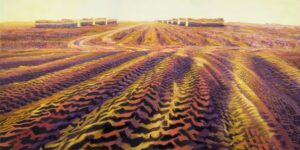
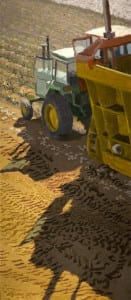
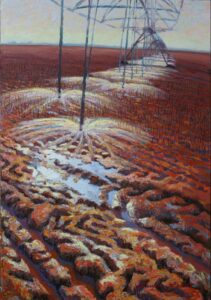
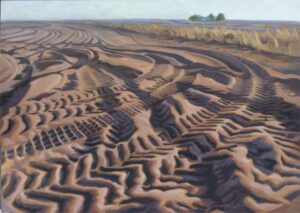
Then I did get back to painting the Brazos again, and here is the evidence of the power of this idea.
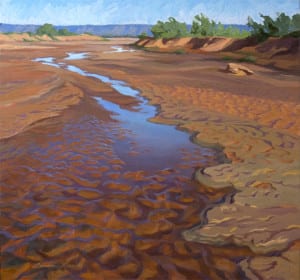
So here I am back at the Brazos River. This painting has more stylistic unity than Miller’s Bend. I am happy with the painting. The water is mostly realistic and I have had more fun with the patterns on the right. The concept of stylistic unity is still driving change in my work and is a challenge I am enjoying wrestling with.
OPA Critiques
Are you interested in having your work critiqued by OPA Signature and Master Signature members? OPA offers this service for a minimal $25 fee that goes to support the preservation of representational art, and you receive expert advice enabling you to become the best painter you can become. Click here to learn more about OPA Critiques.
5 Stages of Painting
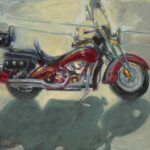
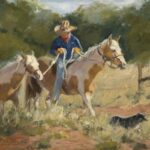
I was teaching in my studio recently and glanced at the bulletin board that I’ve loaded with sketches, ideas and quotes. I had written down the 5 stages of grief at some point and laughed (yes, laughed) at how the same list applies to the work of an artist. If you are an artist I think you’ll be able to relate to this. If you’re a collector, this will give you some idea of how hard our work can be, but you also might find the list applies to your own work, whatever that may be. And, as in life, these stages don’t just run their course and then “you’re done.” They keep repeating. And we keep trying to paint that perfect painting. All artists have a studio full of paintings that will never see the light of a show, but the ones that work make it all worth while!
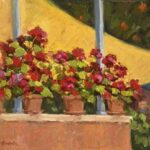
Here’s an idea of what these stages mean to me:
Denial: This is not bad…not the painting I had in my head when I started…but maybe this will work…
Anger: Why isn’t this working? Why can’t I find that color? Why can’t I draw a horse?
Bargaining: OK, if you (the Art God?) just let me get this one painting done in time for the show, I promise I’ll clean up my studio and give up popcorn…and maybe ice cream.
Depression: This is never going to work. What made me think I could paint?
Acceptance: Well, this is not bad. This is going to work for now and the next one will be even better. I hope. I just have to keep working at it and I will get as close as I can before I die.
Repeat 5 stages of Painting. Order may be shuffled as needed.
Good Luck! And don’t give up!
Challenging Painter's Block
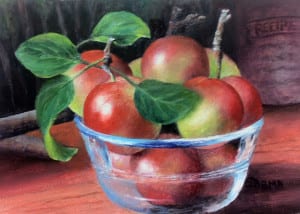
1. Paint your favorite drink – whether it’s a cup of tea, a pina colada, a steaming latte with lots of foam, or an ice cold beer – paint it in such a way that would show the viewer why it’s your favorite and how much you love it.
2. Go through the newspaper and find a photo – the first one that catches your eye – and paint your version of it – it could be abstract, realistic, finger-painted, or painted any way that might get your creative juices flowing for the next project.

4. Paint yourself as a person with the occupation you wanted as a child – did you want to be a fireman, a hairdresser, a bungee jumper, a police officer, a dancer? Give yourself a day as the person of your childhood dreams.
5. Do you love spaghetti? Eggs benedict? Chocolate Mousse? Strawberries? Your secret recipe? Paint it so everyone can taste it with you.
6. Repaint the first thing you ever painted. Just knowing that you now have a greater technical knowledge will help you paint that image with confidence.
7. Paint your worst habit – do you smoke, drink, eat too much chocolate? Paint in a way that will show how bad this habit is. Perhaps your painting, over time, will actually even help you quit your habit – if you even want to.
8. Paint about conformity – peas in a pod, ducks in a row, bananas in a bunch, etc. Make sure that part of your group doesn’t conform – for instance, leave one of the peas out of the pod.
9. Paint yours or your child’s favorite toy. Show some of the worn areas that clearly display how much it has been loved.
10. If you’re really hoping for some particular thing in life – paint it – maybe a cottage at the lake? A diamond ring? A new tool box? A particular make and model of vehicle? A child? Live your dreams through your painting.
Remember that at one time you only dreamed you could paint – now you truly can paint your dreams. Just make those first strokes that will put you back on your way – you can do it – you just need a little motivation. Hopefully you’ll find it here.
© Copyright · Susan Abma